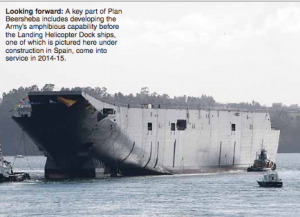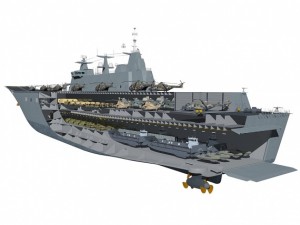2013-05-22 Australia is re-shaping its forces as it deals with the dynamics of change in the Pacific and its roles and tasks post-Afghanistan.
Part of the future approach will be provided by the delivery of a new capability in the Aussie force structure, namely a large LHD or Amphibious Assault Ship.
As reported by the Royal Australian Navy (http://www.navy.gov.au/fleet/ships-boats-craft/lhd):
The Canberra Class Amphibious Assault Ship (LHD), also known as a Landing Helicopter Dock, project will provide the Australian Defence Force with one of the most capable and sophisticated air-land-sea amphibious deployment systems in the world.
These 27,000 tonne ships will be able to land a force of over 2,000 personnel by helicopter and water craft, along with all their weapons, ammunition, vehicles and stores.
The ships are being bought to support Amphibious operations, but will also have a key role in Humanitarian Assistance and Disaster Relief (HA/DR).

The ships are large enough to accommodate the changes in aviation which will see personnel able to operate from the sea platforms in the years to come. The innovations, which the French have shown with a smaller ship, the Mistral, suggest that a larger amphibious ship could evolve with the times, quite nicely.
During the Libyan operations, the French used their premier armed helicopter, the Tiger, for the first time at sea. The Australians are also developing their armed reconnaissance helicopter capability, using the Tiger, so may seek to employ it from a sea platform similar to the French.
In a good overview of Aussie thinking, an Australian defense analyst wrote a piece entitled “in war and peace, an amphibious capability is apt.”
According to John Blaxland, a senior fellow at the Strategic and Defence Studies Centre at the Australian National University:
Australia is in the process of acquiring two amphibious landing helicopter dock ships (LHDs) built by Spain’s Navantia and BAE Systems Australia following the design of the Spanish navy (Armada de Espana) LHD. The first semi-completed one arrived in Australia on October 17, 2012.
On this occasion it is worth reflecting on the parallels of the Spanish and Australian amphibious capabilities. Interestingly, Spain maintains an amphibious fleet of an LHD, two landing platform docking ships (LPDs) and a landing ship tank (LST), sister of former HMA ships Manoora and Kanimbla. This is a configuration not unlike the one the Royal Australian Navy will have once the new LHDs come into operation. Spain lost its Latin American empire two centuries ago; so why does the Spanish navy need a four-ship amphibious capability?
As it turns out, the Spaniards place big emphasis on maintaining an amphibious warfighting capability, with an embarked force drawn from the world’s oldest marine corps, predating the US Marines by more than two centuries (it was created in 1537). The force also includes its own integral onboard air power to operate against adversaries in contested situations. Spain recognises that developing and maintaining its amphibious capability is of the highest order of difficulty. Spain places high priority on ensuring the three armed services work together intimately to make the capability work properly in an opposed setting. But Spain also recognises that this capability enables it at short notice to provide humanitarian assistance and disaster relief…..
The utility of this approach has strong echoes in Australia’s region. With its four-ship amphibious flotilla, Spain was able to act promptly and play a prominent role in disaster relief after the earthquake in Haiti in January 2010, much as they had done after a hurricane in Central America in 1998-99. When port facilities were destroyed and inoperable, Spain’s amphibious ships were able to operate off Haiti’s coast, providing a range of capabilities in support of the international relief efforts, reaching the shore with its amphibious craft and helicopters…..
Australia’s strategic circumstances, with the vast expanse of the Asia-Pacific region vulnerable to significant natural, environmental and other disasters, have pointed to the enduring utility of maintaining robust amphibious capabilities, not only for high-end war fighting, but for all the other assorted challenging tasks the armed forces are often called upon to assist with that might not necessarily be described as war-related. Indeed, experience in recent years has repeatedly demonstrated the utility of Australia maintaining afloat emergency response capabilities. In December 1974 Australia’s last aircraft carrier, HMAS Melbourne, was sent to Darwin to assist with the recovery operations after cyclone Tracy.
Not surprisingly, a very good USMC-Australian working relationship is being fashioned with the new Marine Rotation Force – Darwin operating in Australia’s north. This will be a good way for the Aussies to work through ways to employ their new capability.

As the Commanding Officer of the 31st MEU has put it:
VMM 265 will be chopped to us later this month. We are going to ease into the deployment much as was done with the East Coast MEUs to ensure that we execute wisely with the Ospreys.
They will be part of our training with the Australians when we participate in Talisman Saber this summer. We will be training with them as well at Bradshaw Field, which is a training area, and part of the rotational involvement of the Marines with the Australians. The training will contribute to the Australian effort to get ready to use their own forthcoming amphibious capability as well.
Second Line of Defense learned more about the Aussie transition with an opportunity to discuss the effort with an Aussie Army officer involved in Bold Alligator 2013. LtCol Bonavita is currently the Australian Army liaison officer with the USMC and is based at Quantico. He is finishing the final year of his three-year tour of duty in the United States. He participated last year in Bold Alligator 2012 with two other Aussie officers and in this year’s exercise with one other officer.
Throughout his interview, he emphasized that the Aussies have been preparing for the introduction of their new ships, in part by working with the USMC. LtCol Bonavita said “as far as we [Australia] are concerned, the Marines are the experts on amphibious operations.” Australia will look to share much information with the USMC as its Amphibious capability emerges. This is already occurring with a program of personnel exchanges and combined training.
LtCol Bonavita believes his posting to Quantico has been at the perfect time, because “as the Marines are returning to their amphibious roots, we are rediscovering ours with the introduction of our large amphibious vessels. Simultaneously, the Marines are establishing a presence in Darwin. These two issues have made for a busy assignment in the USA.”.
He also described how the working relationship with the USMC was an important part of the development of the Australian Army itself. “We have done a lot of work with the Marines, including our officers attending USMC courses like the Expeditionary Warfare School, through to participating in exercises like Tailsman Saber, RIMPAC and Expeditionary Warrior, and exchanges with 1st Marine Expeditionary Force (MEF) in San Diego.” The relationships have been enduring. LTCOL Bonavita remarked that “When I was a platoon commander, a USMC company joined our battalion in Townsville as its MEU was deployed. In my current role I have found myself working with some of the very same officers from that Marine Company who are now USMC Colonels. It’s been very positive!”

LtCol Bonavita suggested that continual work with the Marines would help shape the Australian thinking about the new ships and its approach to amphibious operations. “We have a USMC Colonel attached to the Australian Army’s Deployable Joint Force Headquarters within the 1st Division, which is one of the organizations leading our amphibious capability development.”
He also felt that his time at the two Bold Alligator exercises, which he attended, were important in shaping his own understanding of the evolving amphibious operational capabilities.
He was asked about what he thought about the Osprey and he commented that his only negative comment about the aircraft was the limited space inside, but felt it was perfect for amphibious operations.“I was surprised by the ability of the wings to fold on deck allowing a greater number of these aircraft to deploy aboard the ship. I was impressed with the redundancy of systems aboard the aircraft, which make it a very robust aircraft. I was also impressed by its speed and range as well as its ability to land just about everywhere. It really is a capable aircraft.”
He was asked about what he thought was the impact of the Marines exercising in the Northern Territory.
“The decision by the Australian government to invite the Marines to operate in the Northern Territory speaks volumes about the strength and good order of the relationship between Australia and the United States.”
Editor’s Note: The Australian Army approach to amphibious operations and having a force structured to support them is incorpoarated in their transformation is called Plan BEERSHEBA.
According to the Australian Army:
The ability to deploy offshore is crucial and Plan BEERSHEBA will tie in with existing programs to improve the Australian Defence Force’s amphibious capability.
Plan BEERSHEBA introduces the Australia Defence Force’s new amphibious capabilities such as the new Landing Helicopter Docks (LHD) ships which represent a fundamental shift in how Army will deploy land forces and conduct operations in response to the full spectrum of conflict scenarios in the future.
The Army’s Deployable Joint Force Headquarters will foster and develop an amphibious culture across Army. To reinforce Army’s commitment, the Chief of Army has designated the 2nd Battalion, the Royal Australian Regiment (2 RAR) to form the core of Army’s contribution to a future amphibious force as this development work is done.During an interview with Army News, the Chief of Army explained that with new amphibious ships already in the pipeline, it’s time for Army to ‘make a very significant buy in.’
“What Beersheba is doing is giving the government and the ADF a wider range of options when they looks at the Army. Everything from humanitarian assistance through to warfighting, the Army can do it. The Army can get to that operational area with the right capabilities in the right timeframe and do something about the situation when they get there,” Lieutenant General Morrison said.
The Aussie Army Thinks About the Impact of Amphib Ops

